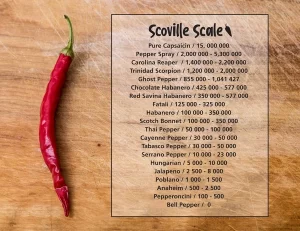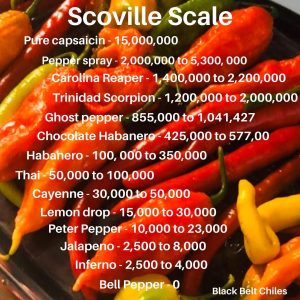In Ancient China, warriors threw hot peppers at their opponents in a bid to fight them off. This fighting method birthed the modern-day use of pepper spray as a self-defense weapon. The FBI did an extensive research on pepper spray in the 1980s. This prompted people to use pepper spray for self-defense.
Pepper spray is one of the most popular self-defense weapons to date. Its ratings are based on the Pepper Spray Scoville Scale otherwise known as the Scoville Heat Unit (SHU). This is a standard measurement of heat. Most pepper sprays begin at 2,000,000 SHUs.

How Does Pepper Spray Work?
The main component found in pepper spray is Capsaicin. This is the chemical that gives peppers their heat characteristic. It’s harmful to humans and animals. Once in contact with it, you experience an irritation in your eyes, nose, and mouth.
A single spray from a pepper spray can cause several effects. Although temporary, these effects can cause a lot of discomfort. When the fluid from pepper spray touches your face, the inflammatory effect is so strong that it causes your eyes to swell and you become temporarily blind.
The essence of using pepper spray is to stop your attacker or the aggressive animal attacking you before they can harm you. It gives you a chance to run away, seek help, or find a safe place to hide. Its effectiveness makes it a favorite for most people looking for a self-defense weapon to purchase. It’s not only effective, it’s also easy to carry around.
What Are Scoville Units?
Scoville units as mentioned earlier are the units used to rate the heat of pepper spray. They generally measure the amount of Capsaicin in the pepper used in a specific can of pepper spray. The test is done by simply tasting the peppers hence a subjective taste test. To know many SHU is pepper spray it has to undergo this test.
The Scoville rating of most pepper sprays begins in the two million SHU range. The hottest chili pepper which is habanero has around 500,000 SHU. This means the least ranking pepper spray has around four times SHU than the hottest pepper.
A pepper spray with a range of 2 million is effective. However, there are no restrictions on the strength of pepper spray. You can purchase even stronger ones. Some of the strongest pepper sprays that are commercially available have a range of up to 5,000,000 SHU.

How To Measure Pepper Spray
The Scoville Heat Scale is a format used to measure the heat and pungency of pepper spray and chili peppers. This rating measures the active component responsible for the hot sensation found in pepper spray which is Capsaicin. The concentration of Capsaicin determines how high the Scoville rating will be.
Pepper spray manufacturers analyze the Capsaicin content in their products by extracting Capsaicinoids from the peppers. They then measure the concentration through laboratory analysis. High-performance liquid chromatography (HPLC) is what lab techs use to measure this concentration.
Once the results are out, they are presented in Scoville Heat Units (SHUs). These units indicate the level of heat the peppers contain hence the rating of the pepper spray.
Pepper sprays can have varying Scoville ratings. They can range from mild to extremely hot. This depends on the concentration of their Capsaicin. When shopping for pepper spray you must consider the Scoville rating. A higher Scoville rating means the effects of that pepper spray are more sever than one with a low Scoville rating.
Scoville Units in Different Types of Pepper Spray
There are different concentrations and levels in different pepper sprays. Each pepper spray has its own level of effectiveness and potency. Specific brands and products of pepper spray have different Scoville units. Some of these include:
Personal Defense Pepper Spray
These are pepper sprays specially designed for use by individuals for self-defense. Their Scoville ratings generally range from 500,000 to 1,000,000 SHU. The effectiveness of these pepper sprays allows you to deter assailants by causing intense pain, discomfort, and temporary blindness.
Law Enforcement Grade Pepper Spray
Pepper spray as a weapon serves not only individuals but also law enforcement officers. The grade pepper spray is designed for use in the law enforcement department and it has a higher Scoville rating. These pepper sprays range from 500,000 to 2,000,000 SHU. Law enforcement officers use these sprays to stop civilians resisting arrest and they are therefore formulated to give maximum stopping power.
Animal Repellant Animal Spray
Pepper spray was originally used to fight off aggressive animals such as bears and dogs. For this reason, there are pepper sprays formulated specifically for animals. They have a lower Scoville rating that ranges from 100,000 to 500,000 SHU. These sprays ensure you deter animals without permanently harming them.
It’s critical to note that there are other aspects such as OC percentage and spray pattern that you must take into consideration when assessing the effectiveness of pepper spray. To select a reliable and effective pepper spray, you must consider your specific needs. With an appropriate Scoville rating and spray pattern, you can rest assures that your self defense weapon will work for you.
Conclusion
Pepper spray is a modern-day self-defense tool used by individuals or law enforcement officers to deter animals and assailants. To make an informed decision on the brand and product of pepper spray you want to buy, you need to understand the pepper spray SHU rating.
The Scoville Heat Scale is a format used to determine the pungency of pepper spray by measuring its Capsaicin content. By knowing the Scoville rating of your pepper spray, you are able to gauge its effectiveness and potency.
The Scoville ratings of pepper sprays also differ depending on their purpose. Law enforcement pepper sprays have the highest Scoville ratings followed by Personal defense pepper sprays and lastly Animal repellant sprays. The higher the Scoville rating, the more severe the effects. It’s important to conduct research and find out what ratings are more convenient for your personal use. Stay informed and prepared for any form of harm.
 Written by: Georgina Njoki
Written by: Georgina Njoki
Freelance Copywriter and Travel Enthusiast.
LinkedIn
